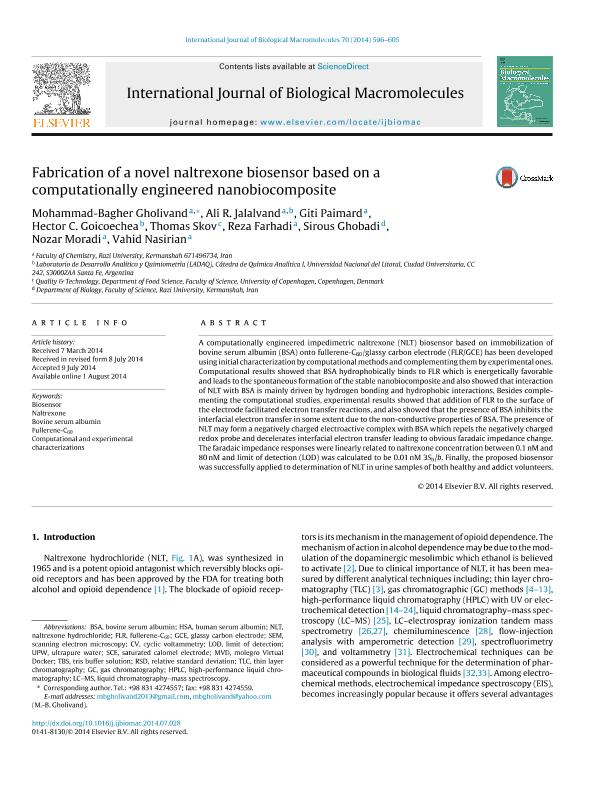Artículo
Fabrication of a novel naltrexone biosensor based on a computationally engineered nanobiocomposite
Gholivand, Mohammad Bagher; Jalalvand, Ali R.; Paimard, Giti; Goicoechea, Hector Casimiro ; Skov, Thomas; Farhadi, Reza; Ghobadi, Sirous; Moradi, Nozar; Nasirian, Vahid
; Skov, Thomas; Farhadi, Reza; Ghobadi, Sirous; Moradi, Nozar; Nasirian, Vahid
 ; Skov, Thomas; Farhadi, Reza; Ghobadi, Sirous; Moradi, Nozar; Nasirian, Vahid
; Skov, Thomas; Farhadi, Reza; Ghobadi, Sirous; Moradi, Nozar; Nasirian, Vahid
Fecha de publicación:
09/2014
Editorial:
Elsevier Science
Revista:
International Journal of Biological Macromolecules
ISSN:
0141-8130
Idioma:
Inglés
Tipo de recurso:
Artículo publicado
Clasificación temática:
Resumen
A computationally engineered impedimetric naltrexone (NLT) biosensor based on immobilization of bovine serum albumin (BSA) onto fullerene-C60/glassy carbon electrode (FLR/GCE) has been developed using initial characterization by computational methods and complementing them by experimental ones. Computational results showed that BSA hydrophobically binds to FLR which is energetically favorable and leads to the spontaneous formation of the stable nanobiocomposite and also showed that interaction of NLT with BSA is mainly driven by hydrogen bonding and hydrophobic interactions. Besides complementing the computational studies, experimental results showed that addition of FLR to the surface of the electrode facilitated electron transfer reactions, and also showed that the presence of BSA inhibits the interfacial electron transfer in some extent due to the nonconductive properties of BSA. The presence of NLT may form a negatively charged electroactive complex with BSA which repels the negatively charged redox probe and decelerates interfacial electron transfer leading to obvious faradaic impedance change. The faradaic impedance responses were linearly related to naltrexone concentration between 0.1 nM and 80 nM and limit of detection (LOD) was calculated to be 0.01 nM (3Sb/b). Finally, the proposed biosensor was successfully applied to determination of NLT in urine samples of both healthy and addict volunteers.
Archivos asociados
Licencia
Identificadores
Colecciones
Articulos(CCT - SANTA FE)
Articulos de CTRO.CIENTIFICO TECNOL.CONICET - SANTA FE
Articulos de CTRO.CIENTIFICO TECNOL.CONICET - SANTA FE
Citación
Gholivand, Mohammad Bagher; Jalalvand, Ali R.; Paimard, Giti; Goicoechea, Hector Casimiro; Skov, Thomas; et al.; Fabrication of a novel naltrexone biosensor based on a computationally engineered nanobiocomposite; Elsevier Science; International Journal of Biological Macromolecules; 70; 9-2014; 596-605
Compartir
Altmétricas



